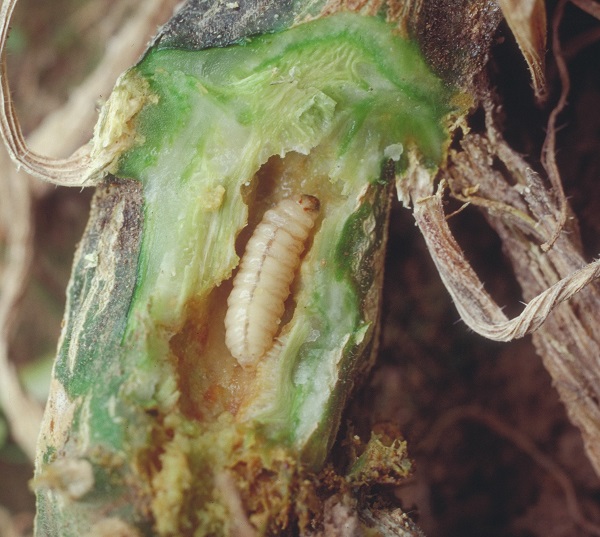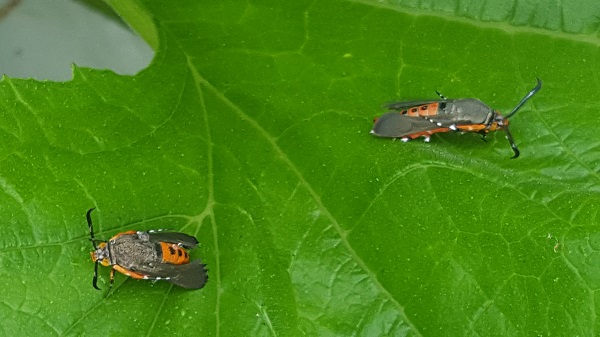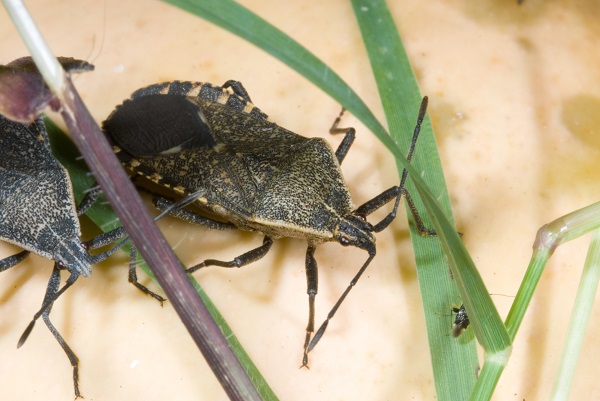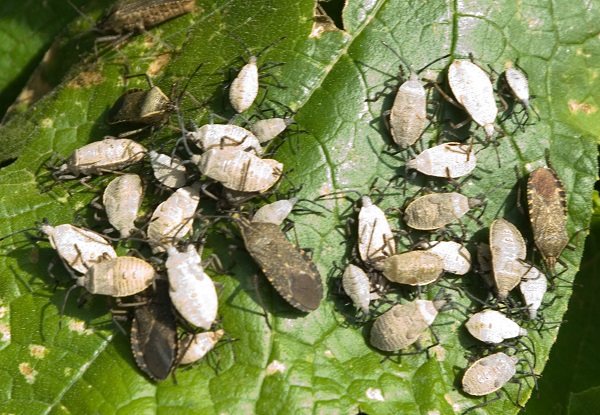Squash Vine Borer and Squash Bug
ENTFACT-314: Squash Vine Borer and Squash Bug | Download PDF
Ric Bessin, Extension Specialist
University of Kentucky College of Agriculture
SQUASH VINE BORER
The squash vine borer is a key pest of winter squash, gourds and pumpkins in Kentucky. Unfortunately, it is usually noticed only after it has done its damage. Symptoms appear in mid-summer when a long runner or an entire plant wilts suddenly. Infested vines usually die beyond the point of attack.

Figure 1. Squash vione borer larva tunneling in squash stem.
Sawdust like frass near the base of the plant is the best evidence of squash vine borer activity. Careful examination will uncover yellow brown excrement pushed out through holes in the side of the stem at the point of wilting. If the stem is split open, one to several borers are usually present. The caterpillars reach a length of 1 inch and have a brown head and a cream-colored body. Winter squash, particularly 'Hubbard', are most susceptible to damage while 'Butternut' is somewhat resistant.
The adult squash vine borer is a stout dark gray moth with 'hairy' red hind legs, opaque front wings, and clear hind wings with dark veins. Unlike most moths, they fly about the plants during the daytime, appearing more like a paper wasp than a moth.

Figure 2. Squash vine borer moths on squash leaf.
This insect overwinters as a full-grown larva or a pupa one to two inches below the soil surface. If it has not already done so, the larva pupates in the spring. Adult moths begin to emerge about the time the plants begin to run, and moth flight continues through mid-August.
The small brown eggs, laid individually on leaf stalks and vines, hatch in seven to 10 days. The newly hatched larva immediately bores into the stem. A larva feeds for 14 to 30 days before exiting the stem to pupate in the soil. There are 1 to 2 generations per year in Kentucky.
Management
The key to squash vine borer management is controlling the borers before they enter the stem. Once inside the vine, insecticidal control is ineffective. Poor timing of sprays is the usual cause of inadequate control. Adult emergence occurs at approximately 1000 degree days (base 50F with a Jan 1 biofix) in the early summer. Use 950 degree days as the time to begin monitoring plants weekly for initial signs of the borer's frass at entrance holes in the stems. This usually corresponds to mid-June as the start of the adult flight. Very early signs of larval feeding indicate that other eggs will be hatching soon. Use two insecticide applications 7 days apart to control newly hatching larvae and continue to monitor for additional activity. Sprays need to penetrate the canopy to cover the vines to be effective.
Home gardeners may have some success with deworming the vines. At the first signs of the sawdust like frass on vines, slice lengthwise near where the damage is found and remove the borers. Cover stems immediately with earth. Sanitation is also important. Vines should be removed from the garden and composted after harvest is complete to prevent the remaining borers from completing development. Burying a few nodes along each vine will encourage rooting at these nodes. This will lessen the impact if squash vine borers girdle the base of the vine.
SQUASH BUG
The squash bug is another common pest. While all of the cucurbit crops can be attacked, it shows a preference for squashes and pumpkins. This insect can be very difficult to control when populations are allowed to build.

Figure 3. Squash bug adults.
Squash bugs damage plants by removing sap and causing leaves to wilt and collapse. Young plants and infested leaves on older plants may be killed. More importantly, they are the vector of a newly recognized disease of cucurbit crops, Yellow Vine Decline. Melons, watermelon, and pumpkins are susceptible to this disease. The bacteria that causes this disease is injected into the plant while squash bug feeds with piercing-sucking mouthparts. The disease results in yellowing, wilting and death of the plant. Early infection by the bacteria that causes the disease can result in severe yield loss, so it is very important to prevent squash bugs from feeding on young plants early in the season.

Figure 4. Squash big eggs and newly hatched nymphs.
Only the unmated adult bugs overwinter in Kentucky. Adult squash bugs begin to fly into fields and gardens in late May and early June. Soon after beginning to feed, they start laying eggs, primarily on the undersides in the angle between veins.
The bronze eggs are football shaped and lie on their sides in groups of 12 or more. Eggs hatch in one to two weeks. Initially the larvae are dark red with a light green abdomen.
Older nymphs are light gray in color with black legs. Young nymphs are gregarious and feed together in groups. Nymphs require five to six weeks to mature into adults. Squash bugs spend most of their time around the base and stems of the plants and on the undersides of leaves.

Figure 5. Large squash bug nymphs and adults are common later in the summer.
Management
Timing is the key to successful squash bug control and eliminating squash bugs is the key to yellow vine decline management. Because this insect is a persistent vector of the disease, disease management is dependent on control of the vector. Growers should use insecticides to control squash bugs as soon as the plants are set into or emerge in the field. Early insecticide sprays should target overwintering adults on young plants. Multiple foliar sprays are needed for extended periods of control. Treat with a recommended insecticide listed in https://publications.ca.uky.edu/files/ID36.pdf.
Revised: 11/19
CAUTION! Pesticide recommendations in this publication are registered for use in Kentucky, USA ONLY! The use of some products may not be legal in your state or country. Please check with your local county agent or regulatory official before using any pesticide mentioned in this publication.
Of course, ALWAYS READ AND FOLLOW LABEL DIRECTIONS FOR SAFE USE OF ANY PESTICIDE!
Photos courtesy Ric Bessin, University of Kentucky Entomology
